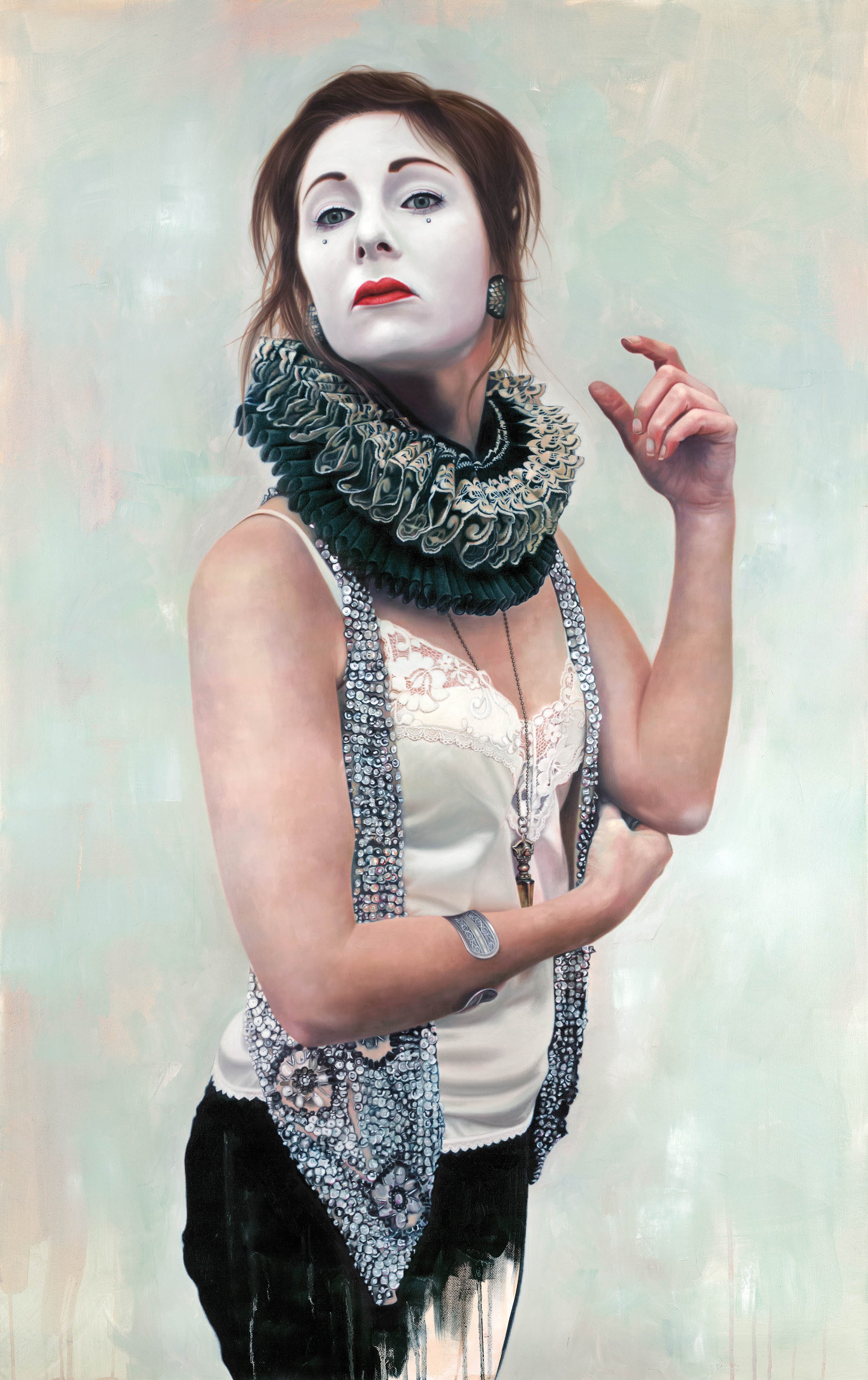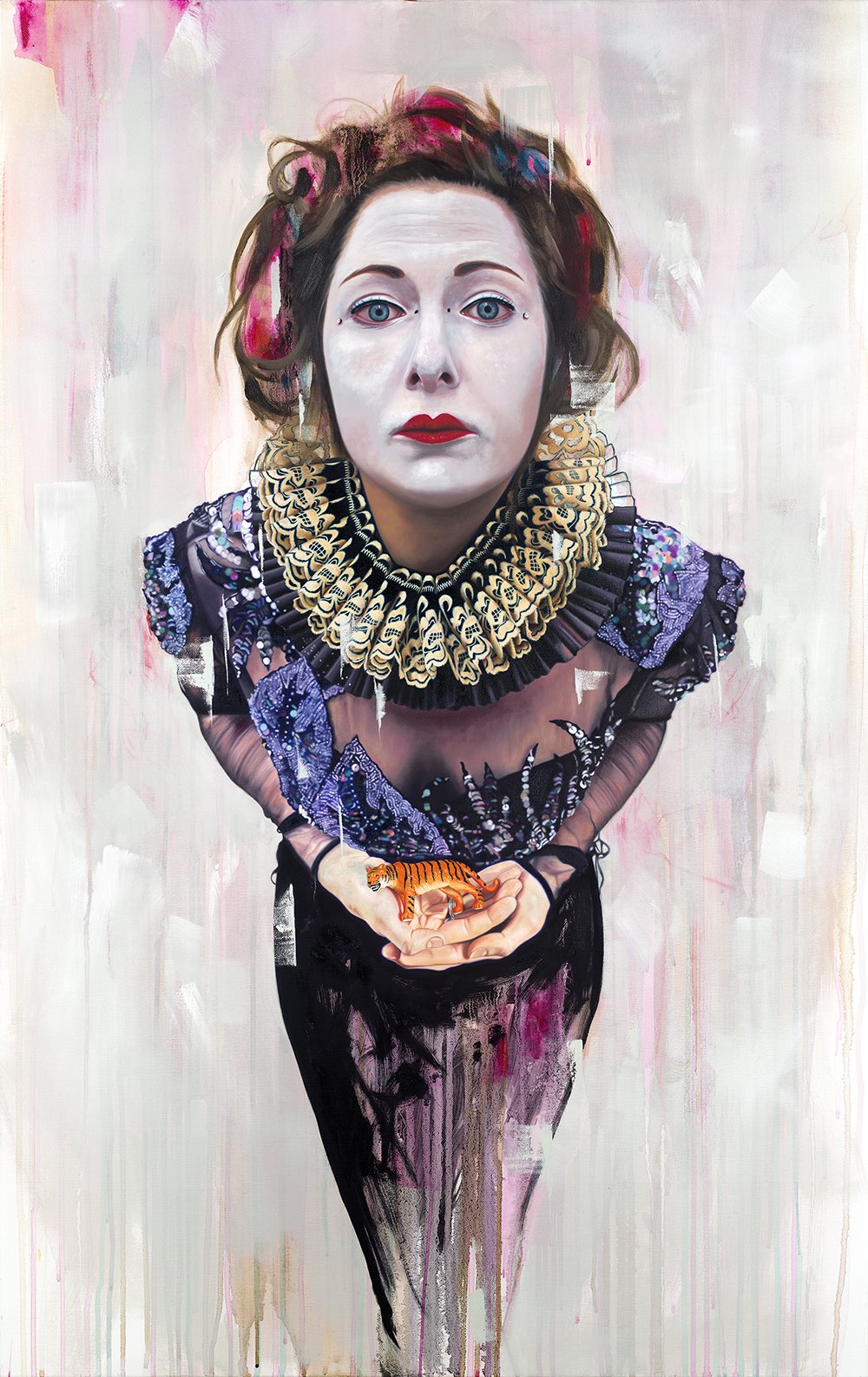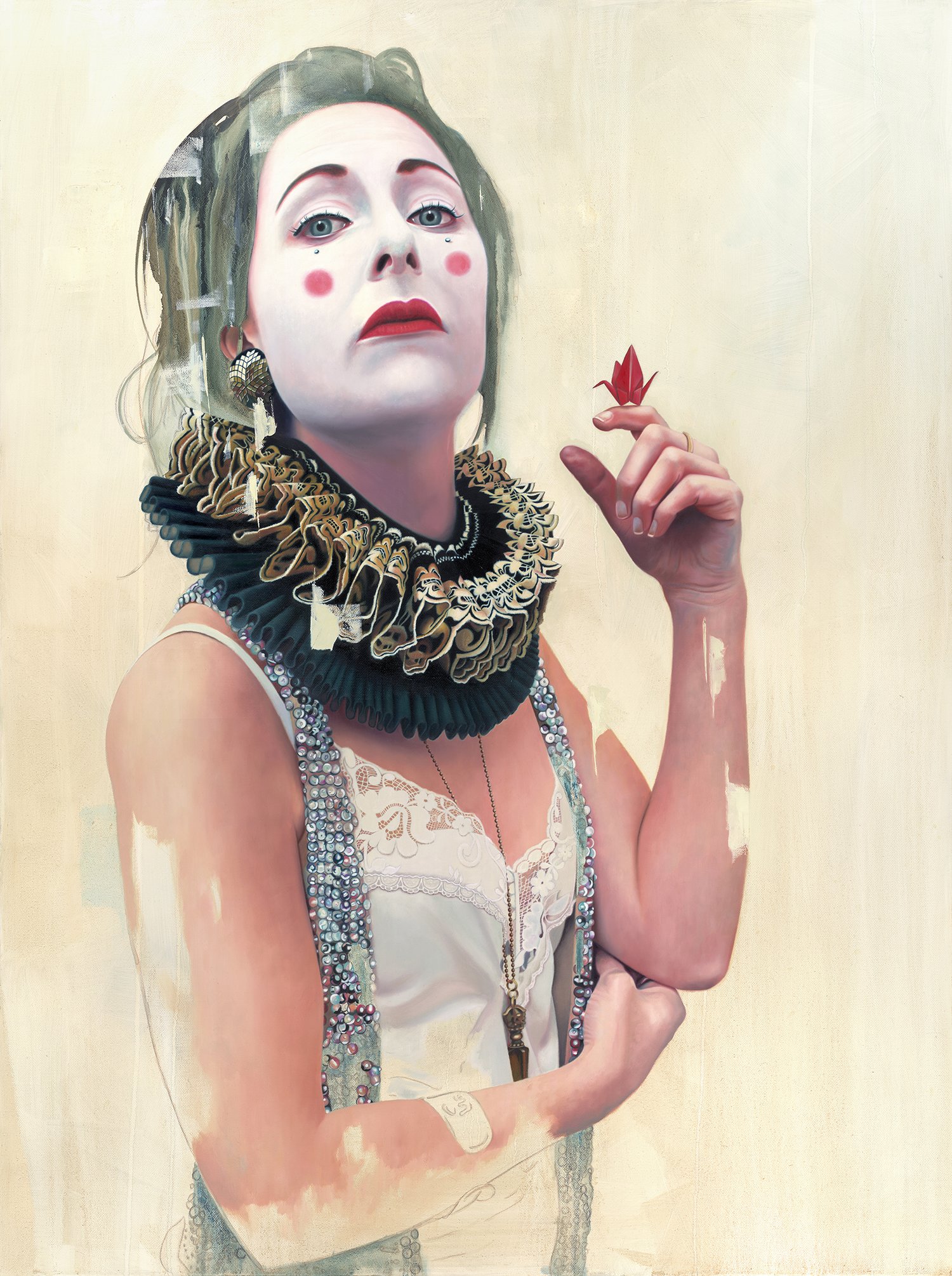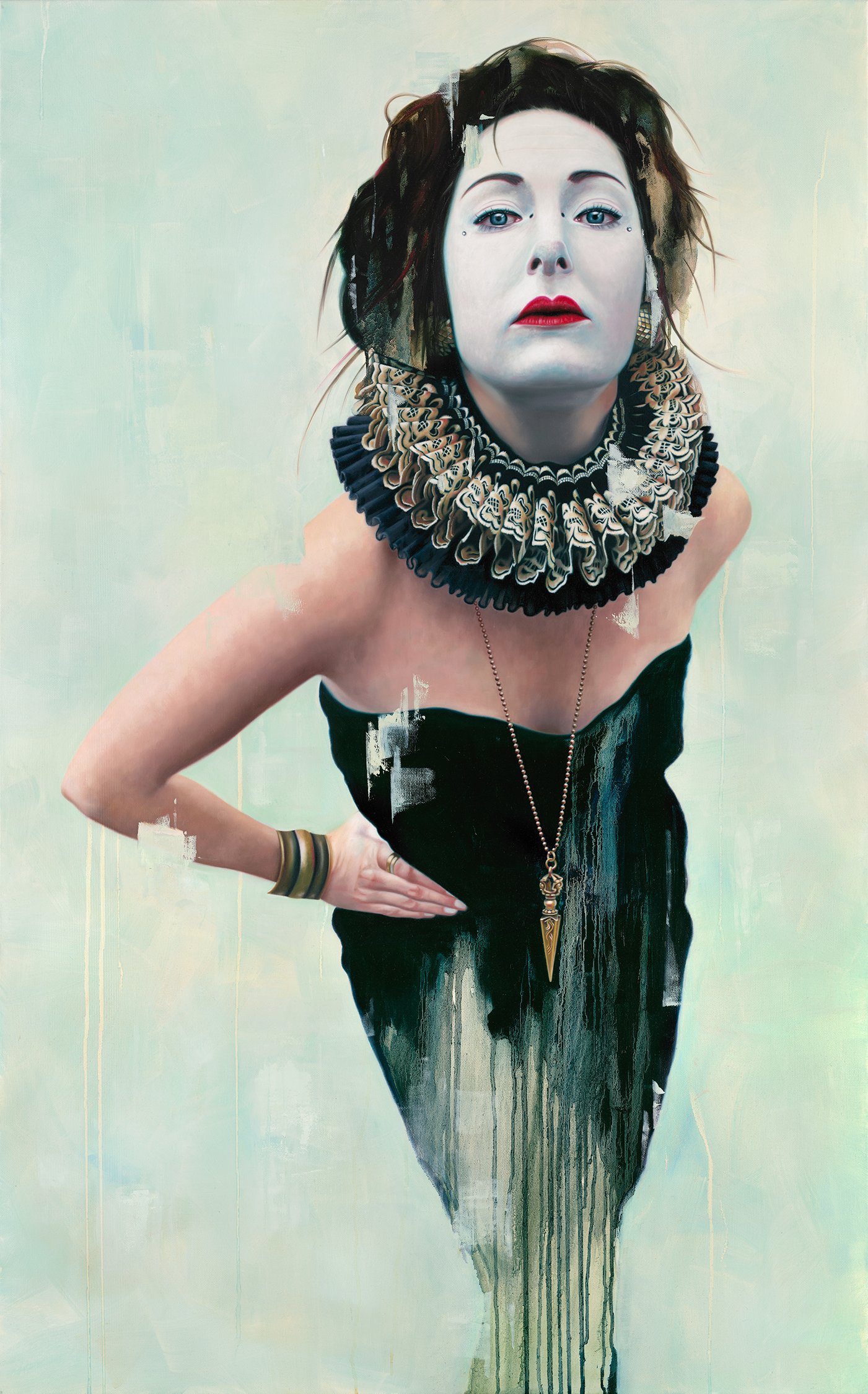ARTIST INTERVIEW: Solly Solomon
Tell me about yourself. What inspired you to become an artist? How has your upbringing influenced your artwork?
I’m not sure if I can recall being inspired to become an artist because I felt like I just knew that I was one. In the same way that I’ve always known it would never be my destiny to become an accountant! I grew up from the age of six having watercolour lessons with my Gran, who was a floral artist. Looking back, I think both working in watercolours and painting flowers, are two of the most challenging aspects of painting and so it was a good grounding in that respect. She brought me up from the age of eight. I would walk into her room every day and watch her paint or draw, I think a lot of it I absorbed just through the act of observing her and listening to her talk through her processes and colour mixing. You can learn a lot like that – how to think like an artist.
Identity is a common theme throughout your paintings. How have you been able to portray your own identity through your artwork? What are the key characteristics of your art that define you as an artist?
A lot of the way my work has evolved has felt very natural and intuitive. I didn’t consciously intend to put certain themes into my work, I have found they have emerged within it. I would say that although I paint various models, they always seem to become symbolic of myself, and in that way they become a kind of self-portrait, even if not in the literal sense. So even when I am not painting myself, I am painting about myself, about my life. This is not intended to be a form of narcissism, but rather a way of processing and expressing my experiences. Visually, my work has developed consistent themes of figurative female realism, with strong makeup and theatrical overtones.
How has your background in musical theatre shaped your paintings? How do the nods to the Elizabethan era relate to the narrative of your pieces?
The theatre has definitely been inspiring in an aesthetic sense. In a way it’s been a kind of organic process because my work has always been very autobiographical in nature. For example, I did literally used to wear white makeup in an attempt to hide the colour of my cheeks (which was to be one of very many makeup mistakes I have unfortunately made over the years.) This masking felt like it was intrinsically linked to theatre and the idea of the sad clown, of Pierrot, of the idea of hiding your emotions from others, of putting on a happy performance whilst at the same time literally hiding yourself. I see the ruff as an extension of this costume, of this mask.
How do you approach a painting? Describe your creative process from the start to finish of a piece.
My paintings initially start by finding a model and working out the costume and accessories and then doing a photoshoot. Once I have a bank of photos, I go through and select the ones I like, forming a short list that I then go on to edit in Photoshop. I project the chosen image onto canvas and then due to the size of the work and the type of projector I have, I then need to go back and manually fill in all the missing information in the drawing. A black ruff will usually only project a rough outline, which is enough to work out the size and placement, but then I spend a long time working out all the folds. I then go over the drawing with a watercolour pencil to make it more prominent. After that it is a case of working through the many layers of the different aspects of the painting, referring to the photo that will be blown up on my computer screen. I don’t work general to specific as a classical painter might, but neither do I window shade where a painter might work on just one section at a time, finishing as they go along. I tend to move around the painting a lot and work on the parts that are currently dry, working in layers. Some areas, such as the face, will have at least four layers, a ruff will usually have three, whereas sequins, like the background, will generally only have one.
What would you like people to think about when they view your artwork?
I am not really that concerned about what people ‘think’ about when they look at my work, they can think what they like. What I am more interested in is how people feel when they look at my work. I would like people to feel or be at least able to sense some of the emotion that is in the work. Recently, I exhibited with another artist who said that my painting made him feel ‘exposed’, like the model was really looking right inside of him. I liked that. That feels powerful.
How does painting make you feel? Has art helped you in your own personal life?
Painting feels like a necessity and I get frustrated at the times when life takes me away from it. I think in all honesty, it is a form of escapism for me, I like to put on an audiobook and retreat from the thoughts whirling around in my head. Yet these oddly have a way of weaving themselves into the work despite this. Originally, I never consciously intended to put my feelings into my work, but this is something that has always happened. Often at times it feels easier to work things out through imagery and paint, or through the written word than it does through speech.
What are you working on currently? What are your future ambitions with your art?
I am currently working on a series of self-portraits, these are taking me into a new and uncomfortable territory because they are nude. I haven’t tackled the naked form before embarking on this project and it’s also something that obviously feels very exposing. However, I felt that I wanted to explore how adverse childhood experiences and trauma have impacted the relationship I’ve had with my body throughout my life. I felt like this was an important issue to tackle both on a personal level, but also as a woman because I consider that the more we can try to be open about our difficulties with things such as body image, the less of a power they can have on us and hopefully the more others can feel like they are not alone.
Who is your favourite artist? If they were sat next to you right now, what would you ask them? Do they have an influence on your work?
That’s a really tough question, there are so many! If I had to pick one whose work is especially significant I’d probably go with Jenny Saville. When I was a teenager doing my A-Level Art and coping with an eating disorder, I found her work to be so monstrous and grotesque that I couldn’t bear to look at it. Over the years my attitude towards her work has changed and now I find it to be incredible. I like how powerful her work is and that years ago its power over me was such that I simply couldn’t confront it. I would love to be as brave as Saville. Both in the execution of my brushstrokes and in the subject matter.
Why do you think art is important in society?
I think art is about the experience of being human, and it is something that transcends gender, age, race, social status, religion and unites us all in our humanity. I think of art as an umbrella term for many of the ‘arts’, be that painting, music, literature, theatre, dance – all of these genres speak to that which makes us human, of what it is to experience the world and all the plethora of emotions that encompass that - be it joy, compassion, pain, grief, shame or love, for these are the things that we all feel at some point along our journey through life, regardless of who we are.










